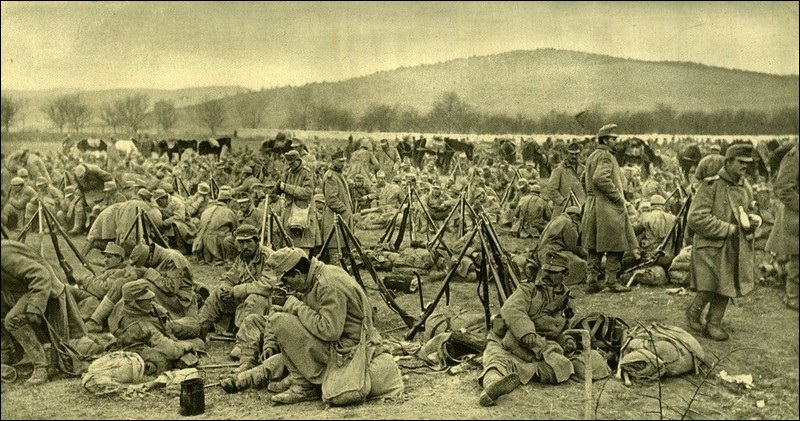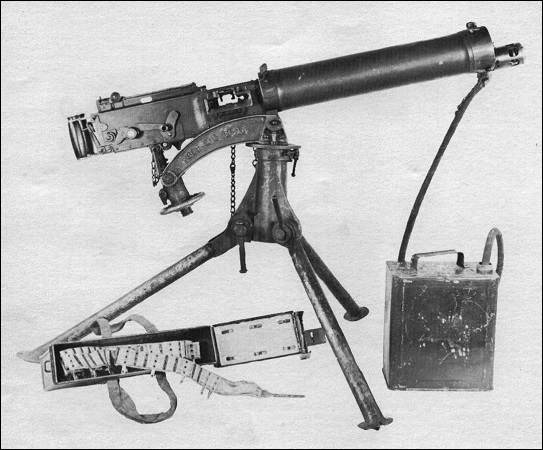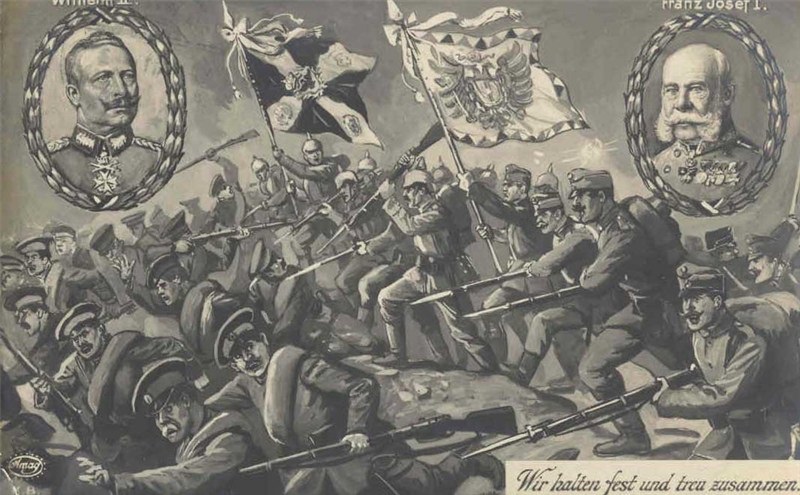● ● ●
With the conclusion of the Battle
of Flanders and the onset of winter, fighting on the Western
Front died down. Both sides were exhausted and frustrated by
the failure of their initial plans. But General Joffre, the
French commander-in-chief, remained steadfast in his
determination to resume the offensive at the earliest
possible moment. Ever the optimist, he was undaunted by the
horrific casualties suffered by the French armies in the
Battle of the Frontiers. The Germans too, he argued, had
suffered heavily and were vulnerable to attack in the great
bulging salient between Arras and Rheims (see map
here). But as
events were to show, Joffre both overestimated German losses
and underestimated the strength of the defense in trench
warfare. The British, whose army in France was slowly
expanding, were of similar mind. On the Allied side there
was no doubt among the military commanders that it was both
necessary and possible to win the war by defeating the
Germans in France and Flanders. As yet only a few isolated
voices—Winston Churchill’s prominent among them—were
suggesting that there might be strategic opportunities
elsewhere.
On the German side, however,
disagreements had already arisen between General von
Falkenhayn, the Chief of the OHL, and the heroes of the
Battle of Tannenburg. Generals Hindenburg and Ludendorff—the
Duo as they came to be called—argued that the vulnerability
of Russia, so plainly evident in the opening round,
presented a golden opportunity. If Russia could be knocked
out of the war Germany would then be free to concentrate
against the Allies on the Western Front, thus guaranteeing
victory.
Falkenhayn disagreed. He doubted
that it was possible decisively to defeat Russia—a huge
country, rich in manpower, whose vast spaces would swallow
up the German and Austrian armies. Despite the
unsatisfactory outcome of the opening campaign in the west
Falkenhayn remained convinced that France and Flanders
constituted the decisive theater of war. Thus originated the
long, acrimonious strategic debate between Germany’s
“westerners” and “easterners.” It was a debate complicated
by the shaky condition of the Austrian armies, which had
been so soundly trounced in the opening round. Much against
his inclination, Falkenhayn was compelled to dispatch
reinforcements to bolster up the Austrian sector of the
Eastern Front. Whatever its military deficiencies, Germany
could ill afford to lose the Austro-Hungarian ally.

Austro-Hungarian troops on
the Eastern Front, winter 1914-15 (Heeresgeschichtliches
Museum)
Another complication was
Falkenhayn’s conviction that further offensives in the west
would be futile. The Germans’ failure to break through at
Ypres in October-November 1914—though they came close to
doing so—and the high casualties sustained had shaken his
faith in victory by decisive battle. He now argued—and here
the Chief of the OHL was prescient—that the war would last a
long time, that it would be a war of material, and that
attrition would determine the outcome. In effect, he
reverted to the strategy of Ermattungsstrategie,
exhaustion of the enemy.
Falkenhayn therefore set about mobilizing the German economy
for a long conflict. Plans were laid for great increases in
production of machine guns, heavy artillery and munitions.
The allocation of labor, essential raw material and
foodstuffs was brought under control of the War Ministry. By
these means Germany gained a march on the Allies, who were
slower to recognize that fundamental changes in the nature
of war were occurring. Only gradually would it dawn on them
that the Great War was a peoples’ war, with the armed forces
just the spearhead of a mighty national effort.
On the Western Front itself, the
crude entrenchments of the early days were being expanded
and improved, and here again the Germans were ahead of the
Allies. The trenches they dug were deeper, better
constructed and better sited than those of the British and
French. Much thought and effort were devoted to the development
of an integrated defense based on machine guns and
artillery. This was in sharp contrast to the French and,
particularly, the British attitude. When proposals were made
to increase the British infantry’s allocation of machine
guns from the paltry prewar scale of two per battalion to
sixteen per battalion, senior commanders in France were loud
in their objections. General Sir Douglas Haig, commanding
the First Army, argued that the machine gun was “a much
over-rated weapon,” and that two per battalion were more
than sufficient. Field Marshal Lord Kitchener, the Secretary
of State for War, thought that four per battalion would
surely be adequate. Eventually the generals were overruled
but their resistance to a weapon that had more than proved
its worth in the opening round was an ominous portent.

"A much over-rated
weapon": the British Vickers caliber .303 machine gun
(Imperial War Museum)
On the Eastern Front the situation
was rather different. There, thanks to the great length of
the front relative to the number of troops engaged, a war of
movement remained possible. Trench warfare was not unknown
in the east but it never became absolutely dominant, as
happened in the west.
The opening round in the east had
ended in a German victory over the Russians in East Prussia
and a Russian victory over the Austrians in Galicia. These
results intensified a dispute in the Russian military
command that predated the war: Where to place the main
effort? As Germany had “westerners” and “easterners,” the
Russians had “northerners” and “southerners.” The former
advocated placing the main effort against Germany, seen as
the main enemy; the latter argued for placing it against
Austria-Hungary, seen as easier to defeat. The dispute had
not been resolved before the outbreak of the war, so that
Russia conducted two completely separate campaigns in the
opening round—and nobody’s mind was changed by either the
Tannenburg debacle or the victory in Galicia. The
northerners alleged that the invasion of East Prussia had
failed because it was undertaken prematurely, before the
Russian Army was fully mobilized. The southerners offered
the collapse of the Austrian armies in Galicia as proof that
they had been right all along. Again the dispute was not
resolved and the Russian Army continued to fight two
separate wars, with much bickering between the commanders
involved as to the allocation of material and reserves.
A more immediate problem, however,
was a shortage of weapons and munitions—the Russian Ministry
of War and General Staff having greatly underestimated the
rate at which both would be consumed. Prewar stocks were
largely used up in the opening round and production was
quite inadequate to cover requirements—no provision having
been made for a large-scale conversion of industry to meet
wartime needs. The resulting shortages, serious enough in
themselves, also provided the generals with a convenient
excuse for their repeated failures against the Germans. As a
matter of fact the shell shortage as it was called was never
as dire as the generals alleged, and many of the defeats
they sustained at the hands of the Germans could have been
prevented or at least ameliorated by more sensible planning
and tactics.
So as Europe entered the first
winter of the war, the Allies in the west busied themselves
with plans for the offensives of 1915 that would, they were
confident, overthrow the German Army. In the east, Germany
was preoccupied with the necessity of shoring up the
Austrian front in the Carpathians, where continued Russian
pressure threatened a breakthrough into Hungary that would
be disastrous for the Habsburg Monarchy. Falkenhayn,
resigning himself to the inevitable, therefore decided that
in view of the Austro-Hungarian emergency, the main German
effort for 1915 would have to be made in the east. If it
could not be decisively defeated, the Russian Army must at
least be neutralized. To that end, considerable forces were
taken from the Western Front for dispatch to Poland, and the Austrians were browbeaten into accepting a
unified command arrangement for the Eastern Front. As a
first step, Falkenhayn planned a limited offensive, to be
launched in mid-November, with the objective of destroying
Russian forces in the Polish salient.

A contemporary postcard
celebrating the Austro-German alliance; the reality was
somewhat different (FirstWorldWar.com)
A complicating factor for the
Central Powers was the possibility—increasingly likely in
view of the Austro-Hungarian emergency—that Italy would
enter the war. That country had bailed out of the Triple
Alliance in August 1914, arguing that Austria’s aggression
against Serbia negated its treaty obligations. And though
the Italian government declared neutrality, its designs on
the Austrian Trentino, Trieste and the eastern Adriatic
littoral were hardly a secret. Italy thus found itself in the
congenial position of soliciting bids for its support in the
war. Germany pressed the Austrians to yield up some
territory in exchange for continued Italian neutrality,
adding in an undertone that after victory it could always be
taken back. The Allies offered to support Italy’s annexation
of the desired territories in exchange for its entry into
the war.
But for the moment the Italians
hesitated; not all political factions in Italy were in favor
of war. By and large the liberal-nationalist government and
its supporters were the war hawks; the socialists and the
conservatives mostly opposed intervention. But with the
string of defeats suffered by the Austrians in Serbia and
Galicia, the temptation to take the plunge grew stronger and
stronger.
Thus as 1914 drew to a close, few
among the belligerents were willing as yet to admit that
militarily the war was deadlocked. With the significant
exception of Falkenhayn, the generals remained confident
that with more troops and more firepower that they could
overcome their difficulties and achieve decisive victory. In
1915, a second round of battles, west and east, would put
that confidence to the test.